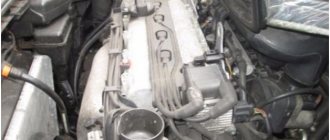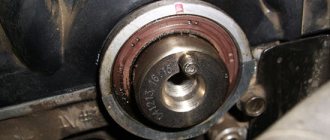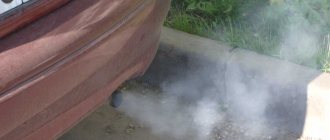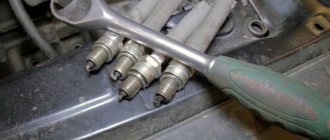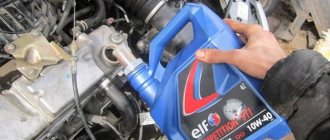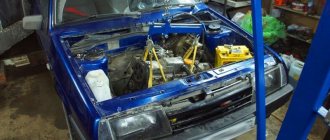Why is oil in the engine intercooler bad?
When an engine operates with a turbine, increased heating of the engine occurs, since the injection of air into the combustion chambers leads to its compression and, as a result, the temperature increases. This changes the fuel combustion mode, which can lead to burnout of valves and pistons. The intercooler is a cooling radiator through which the air pumped by the turbine passes. Reasons for lubricant penetration into the intercooler:
- the tray ventilation is not functioning correctly;
- the oil filter is dirty;
- the engine air filter is clogged;
- the turbine drives oil into the intercooler due to a faulty oil seal;
- broken turbine oil return pipe.
The consequences of such breakdowns, left unattended, can lead to high costs for engine restoration.
Problems with the crankcase ventilation system
In the ragged rhythm of the engine, during acceleration, off-road driving, the burning fuel-air mixture creates pressure much higher than usual. This increases the volume of gases penetrating through the piston rings into the engine sump. Properly functioning pan ventilation allows gases to move freely into the intercooler, and then into the combustion chambers along with the air-fuel mixture. Due to the fact that the operation of the oil trap gradually deteriorates, as well as the valve springs, the pressure in the pan increases, which is why the exhaust gases begin to drive oil droplets into the intercooler.
After cooling, the oil that gets into the intercooler accumulates at the bottom of the radiator. In addition, the oil begins to lose its properties, which causes the turbine’s lubrication to deteriorate and wear marks to form on the shaft. Another negative aspect that can result from poor functioning of this system is a decrease in engine power and an increase in fuel consumption. Due to the fact that the air flow throws oil into the intercooler, and from there it enters the cylinders, the fuel combustion mode changes.
Air filter clogged with dust
When the intake valves open, the connecting rod goes down, and a significant vacuum is created in the pipe connected to the outlet of the pan ventilation system. When the air filter is clogged, due to the difference in pressure in the pipe and the pan, gases escape much more intensely, taking oil particles with them. In this case, the efficiency of the oil trap decreases, and the lubricant flies into the intercooler. In addition, air deficiency affects the quality of the combustible mixture. The fuel-air emulsion becomes too rich, and lubricant particles that enter the combustion chambers further change the proportion of fuel to air.
Engine overheating
Boiling of coolant in the engine is mainly associated with long operation of the unit at maximum power. If this happens, then the increased formation of lubricant vapors caused by an increase in temperature is added to the volume of gases escaping from the combustion chambers. When the coolant boils, the formation of a vapor lock in the motor head is inevitable. The temperature of the cylinder head increases significantly, which increases oil evaporation. Overheating increases the fluidity of the oil, and it can seep through microcracks in worn oil seals. For this reason, the impeller pumps air with lubricant particles and this affects the functioning of the motor, reducing its wear resistance, as well as worsening operating parameters.
Turbine malfunction due to seal damage
The turbine's service life is designed to last about 150 thousand km, provided that high-quality lubricant and standard pressure are used in the oil system. A drop in oil quality or an increase in pressure leads to a leak in the oil seal, which causes the turbine to throw lubricant into the intercooler. The radiator can serve as an oil catcher for some time, preventing lubricant particles from entering the combustion chambers. When the oil level in the intercooler reaches the limits of the lower cells, a carburetion effect is created and lubricant particles are drawn into the air flow, changing the properties of the combustible mixture.
Risks arising when filling the intercooler with oil
The intercooler of a diesel engine with a mileage of more than 100 thousand km contains 30-60 grams of lubricant. The presence of oil below the level of the internal cells does not cause interruptions in engine operation. When the radiator is filled with lubricant to the lower cells, it begins to be intensively drawn into the combustion chambers with air, which is why the mixture of fuel and air burns poorly. A detonation effect occurs in the engine head and exhaust pipes, which is observed when the remaining fuel emulsion burns out. As a result, the valves burn out, along with the exhaust manifold.
Due to overheating, the collector heats up to 600-700 degrees, heating the engine. The cooling system malfunctions, the unit overheats, losing its service life.
What to do if there is oil in the intercooler
If grease is detected on the surface or inside the radiator, you need to diagnose the cause of its appearance. What you will need for this:
- check the operation of the pan ventilation;
- replace the filter;
- inspect the seals.
If you have no experience in carrying out such work, you can contact specialists at the service center. If the engine is fully operational, based on the diagnostic results, it is worth adjusting your driving style. Thus, operating the power unit at speeds above 2000 per minute leads to excessive heating of the coolant, especially when driving uphill in mountain serpentine conditions.
After completing these measures, flush the intercooler. To do this you will need:
- remove the intercooler from the power plant, using the recommendations from the vehicle maintenance instructions;
- clean the outside of the radiator from oil and dirt;
- The question of how to flush the intercooler is easily solved; for this purpose, gasoline, kerosene, and acetone are used in equal proportions. This mixture is poured inside the radiator for 12 hours;
- For subsequent cleaning of the intercooler from residual flushing mixture, dishwashing detergent mixed with hot water is suitable;
- Flushing the intercooler is completed with clean heated water.
Prompt detection of oil in the intercooler will allow engine malfunctions to be eliminated in a timely manner, preventing a deterioration in its operating parameters. At all stages of radiator flushing, personal protective equipment should be used and detergents should not come into contact with exposed areas of the body.
Optimal operation of the turbocharger is only possible when the rules for using this high-precision mechanism are followed, otherwise problems will arise. Often the cause of breakdowns is the oil in the turbine. What to do if the turbocharger drives oil?
Cleaning and washing parts of the crankcase ventilation system of the VAZ-2109
You will need: a torque wrench, a screwdriver, a new head cover gasket, kerosene, clean rags, a container for washing parts, wrenches for “8 and 10”. Flush every 60,000 km or if the ventilation system is clogged
If the ventilation system is clogged, the pressure in the engine crankcase increases, which can cause oil to leak through the seals and gaskets.
A special sign may be the appearance of oil in the filter housing, especially when driving at high engine speeds.
Unscrew the nut securing the air filter cover and remove the washer.
Unfasten the four spring clips.
Remove the air filter cover.
Remove the filter element from the housing
Loosen the clamps and remove the hoses from the pipes on the cylinder head cover
Unscrew the four nuts
Remove the filter housing from the studs and pull the warm air intake hose off the pipe.
Remove the hose from the filter housing, having first loosened the clamp
Disconnect the plastic holder from the hose, loosen the clamp and remove the hose from the pipe on the cylinder head cover
Unscrew the nut and remove the accelerator cable bracket, leaving the bracket hanging on the cable. Unscrew the two nuts securing the cylinder head cover
Remove the cylinder head cover
Unscrew the two bolts from the inside of the cover
Remove the oil separator housing
Remove the screen from the cylinder head cover.
Wash all parts thoroughly in kerosene.
Install all parts in reverse order.
Before installing the head cover, be sure to replace the gasket.
The nuts securing the cylinder head cover must be tightened to a torque of 2.0–4.5 Nm (0.20–0.45 kgf m)
Types of problems. Possible solutions
1. Oil enters the intake system from the compressor
Possible reasons:
- pipe clogging;
- icing or clogged air filter;
- Damage to a segment of the intake manifold.
To troubleshoot, you need to check the resistance of the incoming air. The vacuum parameters in the air filter area are no more than 20 mm of water column (at idle). If you stop the engine, the rubber pipes will return to their original shape. Finally, it is necessary to free the intake manifold and intercooler from oil. If there are no scratches on the impeller and no beating of the bearings is observed, the turbine does not need to be replaced.
2. Oil enters the engine intake system
There may be a lack of pumped air in the pipes, intercooler, or manifold. It occurs due to a leak that increases the amount of air flowing through the compressor and reduces the pressure. As a result, oil flows out through the compressor part. The leak should be eliminated: replace the gaskets with new ones, tighten the clamps tighter.
It is necessary to check the places from which oil may be lost on the way to the turbine:
- air filter filled with oil;
- brake system compressor;
- closed ventilation system.
3. Oil enters the exhaust system
You should look into the exhaust manifold: most likely it is oil vapors or fuel. Condensation caused by temperature differences is often mistaken for traces of oil. If the turbine on the engine is completely new, and oil is found in the manifold, it is possible that it came from the engine.
4. Oil flows into both systems
There may be two reasons:
- Damaged or clogged oil line, incorrect position of the gasket at the junction with the turbine.
- Malfunction of the engine crankcase, namely clogging of the ventilation system. Excess gases may occur due to problems with the engine or wear of parts. In this case, first you need to troubleshoot. If oil leaks are weak, most likely it is not the turbine that is to blame, but the engine systems.
Often, a car enthusiast concludes that the turbine is faulty due to oil leakage through the cold and/or hot volute into the intake or exhaust manifold. After this, he immediately begins to look for a service where they can perform high-quality work, or rushes in search of a new turbine. However, oil from the turbine can quite often leak due to improper maintenance and operation of the engine, as well as when the engine is worn out or due to improper installation of the turbine on the engine.
To make sure that the turbine is driving oil due to its breakdown, it is necessary to initially check the main components, systems and assemblies of the engine for possible malfunction. If any are identified, eliminate them.
Diagnosing the cause of oil rush
Since there are a large number of reasons for oil leaking through the breather, a comprehensive check of the engine is necessary to determine exactly why the problem arose.
At the same time, to carry it out, you don’t even need to disassemble the power plant, it’s just enough to take measurements of some parameters, as well as visually assess the condition of the ventilation.
For example, let's take the already mentioned VAZ-2110. Let's assume that in the engine of this car, plaque and oil deposits were noticed in the intake manifold, which indicates oil leakage through the breather.
To determine what caused this problem, you will need little - a set of open-end wrenches, a screwdriver, a compression gauge.
We'll start the test by assessing the exhaust gases. To do this, just start the engine and look at their color shade.
If it is gray or black in color, this indicates oil getting into the cylinders due to wear or sticking of the CPG rings or problems with the timing belt. Only this can help determine the cause; read more here - the causes of smoke from the exhaust pipe.
It is also necessary to check the compression in all cylinders. In the normal state of the cylinder-piston group, it should be in the range of 11-13 MPa. The difference between the readings in the cylinders is allowed to be no more than 1 MPa.
If the compression in one cylinder is significantly lower, it can cause oil leakage.
But why exactly this is happening - rings or valves - can be determined by the spark plug that was installed on this cylinder.
Heavy carbon deposits on it will indicate a problem with the CPG.
But if the compression is low, and the spark plug has a normal working appearance without carbon deposits, you should check the valves.
If the compression in all cylinders is normal, we proceed to inspect the elements of the ventilation system.
Where does the oil in the intercooler come from?
Let's look at the main reasons for oil leakage through a working turbocharger. And for a better understanding of the material, let us recall the main design points for the operation of the turbine - lubricant is supplied to the turbine from the engine oil line under pressure, but oil from the turbocharger is drained into the engine crankcase by gravity. Therefore, it is very important when carrying out plumbing or installation work not to deform the drain pipe and the oil supply to the turbine.
1) The picture on the left shows an example of deformation of the drain pipe. As a result, the oil flows out of the turbocharger with difficulty, and the oil that did not have time to flow out by gravity is squeezed out through the seals into a cold or hot scroll in the turbine. An obstacle to drainage can also be coking, the ingress of foreign objects, deformation or bending of the drain line.
2) Monitor the oil level in the engine crankcase; it should be between o and “Max”. If necessary, add oil. When the level is above o, a backstop is created for its gravity drain from the turbocharger. If the level overflows during maintenance, drain the excess oil! The proverb “You can’t spoil porridge with butter” does not apply in this situation.
3) Wear of the engine cylinder-piston group (CPG) leads to the breakthrough of exhaust gases into the sump and the creation of increased pressure in the engine oil crankcase. This fact also prevents the oil from draining by gravity and, accordingly, for this reason the turbine expels it through the seals.
4) The design features of some engines also affect the creation of resistance to gravity drainage of oil from the turbocharger. This occurs when oil is thrown into the oil return line by the counterweight of the engine crankshaft.
5) Check the crankcase gas pressure. Often, the gas pressure in the crankcase increases due to a clogged crankcase ventilation system or breather filter. And in the cold season, an ice plug may form in the crankcase ventilation system (condensation freezes). Both of these facts lead to the turbine visually throwing oil. Clean or replace the crankcase ventilation system (breather filter).
6) This figure shows the ideal conditions for turbine operation. The level is normal. The oil drain line has the correct shape - a straight tube leading into the engine oil sump without bends. The tube is connected to the crankcase in the correct place - just above the oil level in the crankcase.
Owners of old domestic cars, after several years of ownership, can easily write a directory of “diseases” of a particular car model. One of these “sores” is an engine malfunction in which engine oil is squeezed out through the breather. This phenomenon is most often simply called by people: “oil is driven through the breather” or “oil is thrown out through the breather.”
The problem is quite unpleasant and is accompanied by a large number of engine-related problems. It is this problem, as you probably already guessed, that we will talk about in this article. You will learn why oil comes out of the breather and how to solve this problem. Go.
As a rule, the problem occurs with the onset of cold weather, the breather freezes and the oil is squeezed out. This manifests itself in the form of oil drips that are visible from the outside of the engine. Failure to respond to this phenomenon in a timely manner can lead to serious engine damage.
Signs and causes of oil leaking through the breather
Despite its simplicity, this system is very important, and it is necessary to monitor its performance. One of the most common ventilation problems is oil leaking through the breather.
This can become a serious problem in the future, since oil particles entering the manifold and cylinders will clog the channels, and during combustion, increase the amount of soot, which will then enter the crankcase, coking the oil channels, and impairing the operation of the lubrication system.
Signs of oil rut.
There are not many of them. In a carburetor engine, these may be leaks of lubricant inside the air filter housing and significant traces of oil on the filter element itself.
As for injection engines, the problem manifests itself in the form of deposits on the throttle body and the internal surfaces of the intake manifold.
In this case, there may be a drop in engine power and an increase in fuel consumption.
Reasons for oil ejection through the breather.
But there are many of them, and many of them do not relate to ventilation.
Lubricant may flow through this system due to:
- Severe wear of the piston rings and the cylinder-piston group as a whole. Because of this, a very large amount of gases break into the crankcase, and the ventilation simply does not have time to remove them all. Therefore, increased pressure is formed inside the engine, which squeezes oil into the breather;
- Oil separator drain channel is clogged. In this case, the separated oil has nowhere to go, and it is mixed into the passing gases;
- Air filter dirty. The engine sucks in a large amount of air, and if there is not enough air due to a clogged element, the motor will suck it in along with oil from the ventilation system;
- Increased amount of oil in the system. If there is more lubricant in the engine than normal, then excess lubricant will enter the ventilation;
- Ventilation system valve jamming;
- Timing belt wear or valve burnout. As a result, crankcase gases enter the above-valve space, then they penetrate into the crankcase, significantly increasing the pressure.
Operating principle of the crankcase ventilation system
In order to understand why oil is squeezed out of the breather, I propose to briefly consider the principle of operation of the oil system. Not many people know, but for proper operation of the engine, ventilation is necessary, since during its operation gases collect in the crankcase, and now we are not talking about exhaust gases. To ensure the removal of these gases, old cars used a so-called crankcase ventilation system, which after some time became known as a “breather.” With the help of a breather, engineers were able to ventilate the crankcase and thereby relieve the pressure that forms during engine operation. However, the system turned out to be ineffective, since tiny oil particles penetrated the breather along with excess pressure and gases.
The issue of penetration of “oil dust” into the breather was partially resolved by means of a special mesh that traps oil particles and does not let them into the breather. However, despite this, some of the oil vapors still penetrate into the breather, creating certain difficulties for owners. A small amount of oil that has penetrated into the breather is not considered anything terrible, however, if oil flows out of the breather in large quantities, this is a reason to seriously think about the technical condition of the engine.
Operating principle of the engine ventilation system
The design of older models of internal combustion engines included the simplest ventilation system designs; they included only one breather, which was located in the crankcase. It was a link connecting the inside of the cylinder block with the atmosphere, and crankcase gases escaped through it.
This scheme had a significant drawback: the exhaust gases contained oil particles, which were dispersed in the external environment. The negative effect led to significant losses of lubricants and was also a serious factor polluting the atmosphere.
Modern diesel and turbo engines are equipped with closed ventilation systems. A special pipe is connected to the breather, through which exhaust gases are discharged into the cavity of the intake manifold or to the air filter for further movement into the cylinders to participate in the combustion process.
Improved designs eliminate the causes of environmental pollution and do not allow oil particles to be driven into the atmosphere.
On top of that, each engine is equipped with special elements that separate oil particles from gases and return them to the crankcase cavity.
Depending on the manufacturer and model of the car, there are several options for oil separation devices, which differ both in design and in operating principle.
The ventilation systems of diesel power units of modern cars include the following elements:
- Oil separator.
- Breather.
- Two pipes.
- Gas pressure valve.
The appearance of the systems may differ depending on the car model, but the principle of operation and purpose remain the same.
Reasons why oil flows through the breather
- CPG wear. With serious wear of the cylinder-piston group (CPG), in particular the rings, a certain amount of exhaust gases penetrates into the crankcase, resulting in the formation of excess pressure and, as a result, oil loss begins. The oil is squeezed out under great pressure and no mesh can save you from this.
- The oil deflector is clogged. If ventilation is disrupted, oil vapors begin to bypass the purifier, resulting in oil expelled from the breather.
- The air filter is clogged. A clogged filter does not allow the motor to “breathe”. As a result, air is taken from alternative sources, including through the breather, only together with oil.
- Increased oil level. Some motorists do not comply with the requirements specified by the manufacturer and prefer to pour oil to the upper level or higher, citing the fact that there is never too much oil. As a result, the excess oil, as expected, begins to work not in favor, but on the contrary, to the detriment and some of this oil is squeezed out through the breather, in addition, it appears on the air filter.
- The breather valve has failed. A faulty or jammed valve causes exhaust gases to begin to enter the crankcase, as a result the pressure increases and oil is released through the breather.
Breather oil: what to do and how to find the cause
Let's start with the fact that during engine operation, so-called crankcase gases accumulate in the crankcase. To prevent excess pressure from being created, there is a special valve for ventilation. This solution allows the closed crankcase to communicate with the atmosphere. This valve is the breather. In simple words, a breather on an internal combustion engine is actually needed to equalize the pressure inside the engine.
It should be noted that in the crankcase gases mix with oil mist. As a result, lubricant particles enter the breather. Although there is a special oil trap inside the device, a certain part of the oil may escape out. Given this information, minor contamination of the system is acceptable, which is normal. In cases where a lot of lubricant leaks, you should look separately for why oil is leaking from the breather.
Oil leaks through the breather lead to clogged channels, in some cases soot is formed, etc. Excess soot gets into the engine crankcase, coking
Lubrication system
. As a result, loaded parts are less well lubricated and engine wear accelerates. Let us add that traces of oil will not necessarily be visible from the outside in the engine compartment. On
engines with carburetor
in case of leaks through the breather oil in the housing
air filter
or on the filter element itself is a characteristic sign of a malfunction.
On injection engines, traces of oil getting into the throttle area are noticeable, the power unit also loses its throttle response and power, and fuel consumption increases noticeably. It turns out that to check it is necessary not only to inspect the outer surfaces under the hood, but also to remove the air filter, throttle assembly, etc.
Why does oil leak through the breather?
If oil appears from the breather, there may be several reasons. Given the various features, before self-diagnosis, you need to pay attention to additional symptoms.
- First of all, the oil presses as a result of significant wear of the piston rings. This means that gases from the combustion chamber penetrate through the seal into the crankcase, after which too high pressure is created there. Excess pressure causes oil to flow out through the breather.
- Another possible cause could be a clogged oil deflector drain. In this case, gases and oil particles that are no longer able to pass through normally exit through the breather rather than through the cleaner.
- Also on the list is a significant reduction in air filter capacity. In this case, the engine simply does not have enough air at the inlet. The result is the appearance of oil in the filter housing and on the filter itself.
- Possible problems with the breather itself should not be ruled out. As a rule, the valve fails, the passage hole in the breather becomes clogged, etc. Normal ventilation is disrupted, exhaust gases enter the internal combustion engine crankcase and increase the pressure.
- In some cases, overfilling engine oil much higher than the recommended level causes the excess to leak out through the breather. It turns out that excess oil simply presses out of the engine. In such a situation, you should check the lubricant level and adjust it if problems are detected.
Troubleshooting
- The first thing you need to pay attention to is the color of the exhaust, blue or black smoke, a sign of burnt valves or problems with rings.
- Next, you should check the compression in all cylinders. The value on gasoline internal combustion engines should be within 11-13 MPa.
- Disconnect the pipes from the valve covers, air vent and breather. Assess the degree of contamination. If the pipes are very dirty or clogged with oil deposits, use gasoline to clean them or a special carburetor cleaner.
- Check the condition of the oil separator. Unscrew the required bolts to get to this unit. Remove the oil separator and assess its condition. If necessary, clean or rinse followed by drying.
- Inspect and, if necessary, flush the breather valve. There are situations when the valve gets stuck, resulting in exhaust gases entering the crankcase and creating excess pressure. Remove the part and wash it; in most cases, this will resolve the issue of squeezing oil out of the breather.
- Original German autobuffers Power Guard Autobuffers - save money on suspension repairs, increase ground clearance +3 cm, quick and easy installation...
Official website >>>
Intercooler oil is a common problem that indicates a malfunction of various components in the system. Car enthusiasts often complain that oil is forced into the intercooler and a loss of power occurs. The cause can be determined after a detailed diagnosis. And to solve this problem, it is necessary to understand the principle of operation of turbocharged engines and related systems, which will allow you to correctly determine the type of malfunction.
Carrying out diagnostics of lubricant output
To identify the causes of a defect in the flow of lubrication through the breather of a diesel and turbo diesel engine, it is necessary to conduct a comprehensive check of the power unit. This does not require disassembling the engine. Experienced craftsmen measure certain parameters and visually assess the condition of the elements included in the ventilation system.
If plaque and oil deposits are detected in the intake manifold, it is concluded that there is a lubricant outlet through the diesel breather seals. To carry out diagnostics, you will need a set of tools consisting of open-end wrenches, screwdrivers, and a compression tester.
Algorithm of verification activities:
- Analysis of the state of exhaust gases. This turns on the engine and checks the color of the exhaust. A black or bluish tint indicates that oil is getting into the cylinders, because there is wear and sticking of the oil scraper rings, and there are also problems in the operation of the gas distribution mechanism.
- Check compression in each cylinder. The compression value, equal to 11 - 13 MPa, indicates proper operation of the cylinders and pistons. The difference between compressions in the cylinders should not exceed one megapascal. Low compression of one of the cylinders may cause lubricant leakage.
- Using a glow plug, the specific cause of the defect in a given cylinder is determined. The spark plug is removed and checked for strong traces of carbon deposits, which indicate defects in the cylinder-piston group.
- The absence of carbon deposits on the spark plug indicates that the valves need to be checked.
- If compression is normal in all cylinders, it is necessary to further check and clean the elements of the ventilation system. All incoming devices must be dismantled and thoroughly washed, dried, and then reinstalled.
